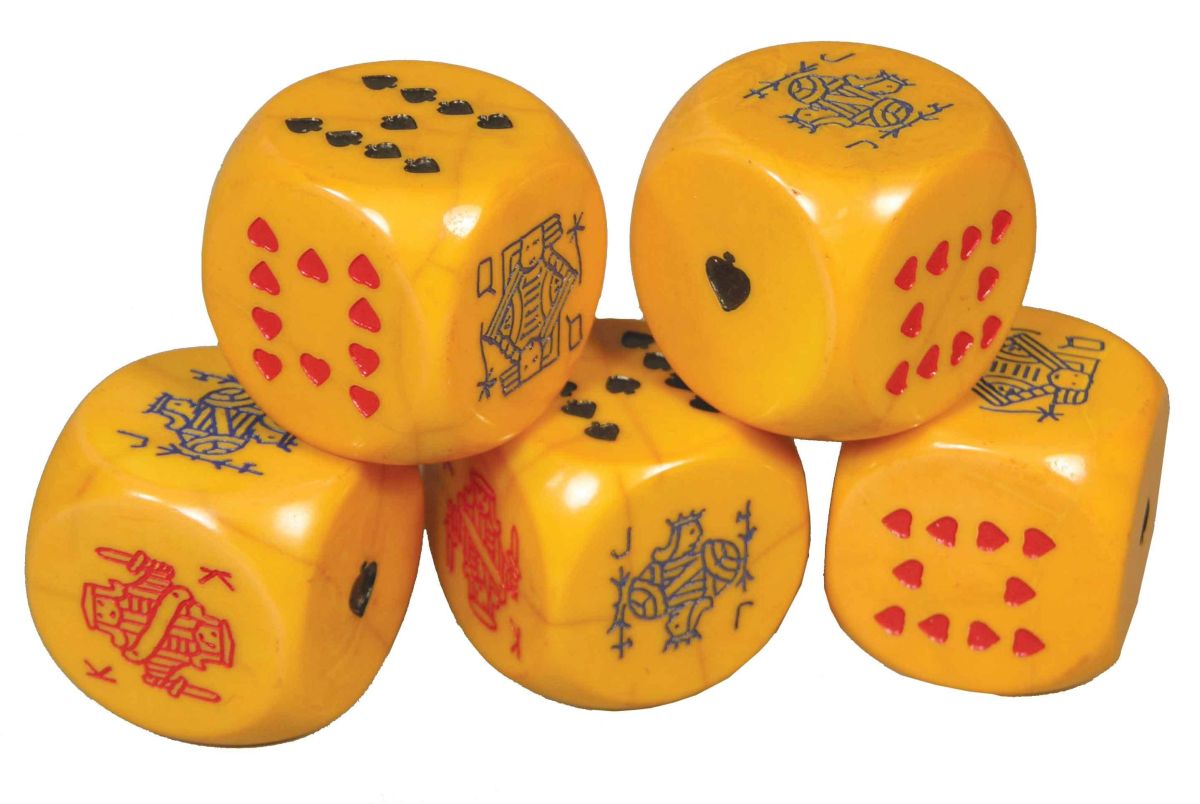It looks like you're using an Ad Blocker.
Please white-list or disable AboveTopSecret.com in your ad-blocking tool.
Thank you.
Some features of ATS will be disabled while you continue to use an ad-blocker.
share:
a reply to: timewalker
In many ways the renaissance re-learning of ancient knowledge and their attitude towards it reminds me of the Sumerians and their approach to learning handed down in secret from the Apkallu;
Of course the latter was largely based upon classical era texts, the Sumerian on what was considered ante-diluvian;
It is of interest to me though as to whether during the renaissance the earlier tradition of recovered knowledge of Mesopotamia also came into consideration, middle Eastern connections, in it's illustrations the Voynich manuscript does suggest this possibility, as there are Persian elements that appear to have crossed into the West through Byzantium, according to artistic analysis, these are most interesting as they do reference earlier traditions.
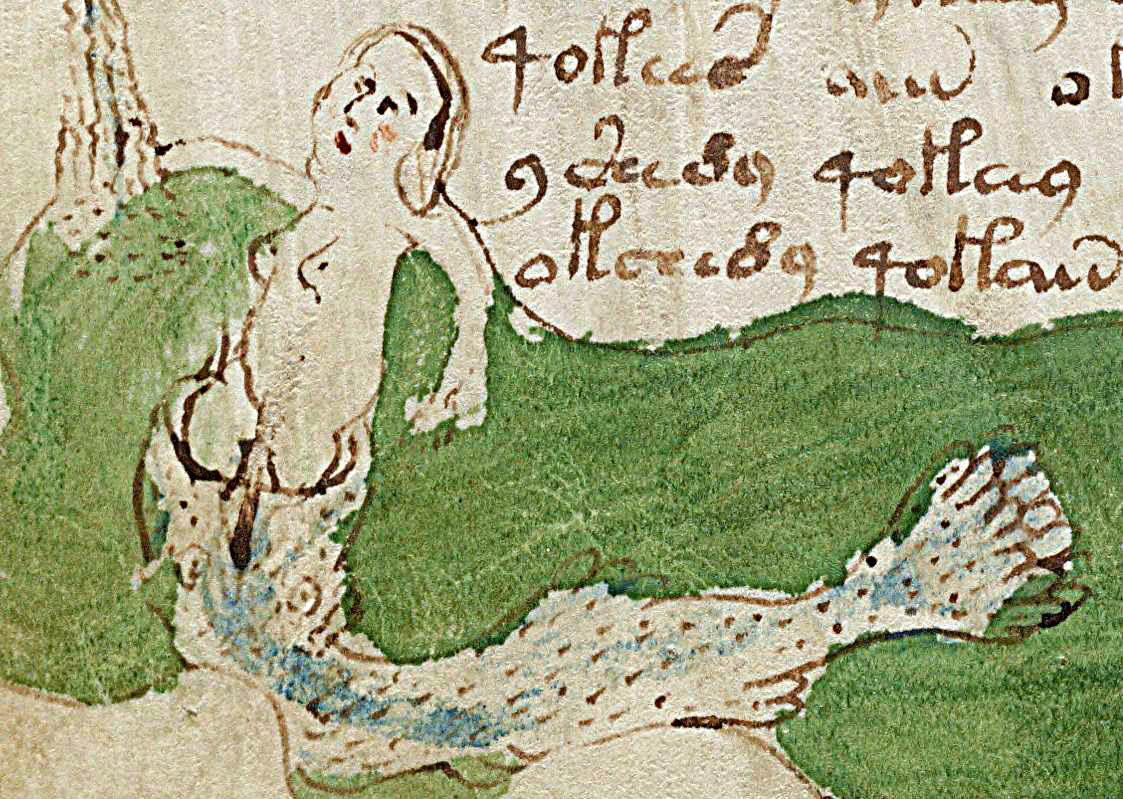
a reply to: Hawke
Except that the manuscript pre-dates her, Caterina Sforza was simply a dedicated follower of fashion.
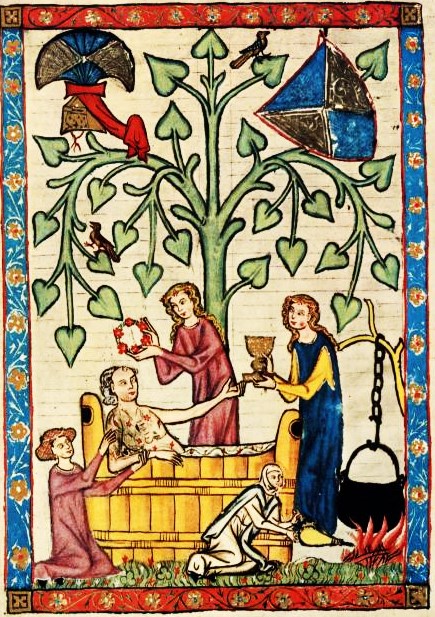
In many ways the renaissance re-learning of ancient knowledge and their attitude towards it reminds me of the Sumerians and their approach to learning handed down in secret from the Apkallu;
Salves (and) bandages: tested (and) checked, which are ready at hand,composed by the ancient apkallus from before the flood, which Enlil-muballit, apkallu of Nippur, bequeathed in Šuruppak
In this case the colophon credentials a human being as the possessor of antediluvian knowledge (i.e., medical recipes). Revealed by primeval apkallù, mediated to the human sage Enlil-muballit, and transmitted, presumably, by means of various copyists to the present possessor
During the time that follows this period, nothing new is invented, the original revelation is only transmitted and unfolded In the oral tradition of scholars, their role as mediators between gods and men is indicated by the Akkadian phrase ša pî um-mānī “from the oral tradition of the masters”
The entire corpus of crafts like exorcism, medicine, omen interpretation , ritual lamentation , and astrology consisted of “secrets of the scholars” (ni ṣirti ummānī ), and “secrets of the antediluvian sages” (ni ṣirti apkall ī ).
All texts of traditional Mesopotamian scholarly sciences, both practical and theoretical, were secret documents
All crafts used in royal building and renovation projects was attributed to that of the antediluvian sages.In a Neo-Babylonian building ritual text from Babylon the prayer “When Anu created heaven” is cited, which explicitly says that Ea created these craftsmen in the beginning of time
Of course the latter was largely based upon classical era texts, the Sumerian on what was considered ante-diluvian;
Favorable days. According to the seven Sages. Duplicate of a tablet from Sippar, Nippur, Babylon, Larsa, Ur, Uruk, and Eridu. The scholars excerpted, selected, and gave it to Nazimuruttash, king of the world.
Each of the exemplars was written by one of the seven sages one after another thereby creating a line of succession for the present tablet that extends back into earliest times.
The claim of this colophon, therefore, is that the tablet of hemerologies over which the ummânù labored goes back to the apkalu and ultimately originated in Eridu, the home city of Ea, an implicit assertion of antediluvian knowledge.
It is of interest to me though as to whether during the renaissance the earlier tradition of recovered knowledge of Mesopotamia also came into consideration, middle Eastern connections, in it's illustrations the Voynich manuscript does suggest this possibility, as there are Persian elements that appear to have crossed into the West through Byzantium, according to artistic analysis, these are most interesting as they do reference earlier traditions.
“Incantation. U-Anna, who accomplishes the plans of heaven and earth,U-Anne-dugga, who is endowed with comprehensive understanding, En-medugga, for whom a good destiny has been decreed, Enmegalamma,who was born in a house, Enmebulugga, who grew up in a pasture land,An-Enlilda, the conjurer of the city of Eridu, Utuabzu, who ascended to heaven, the pure purādu-fishes of the sea, the seven of them, the seven sages, who originated in the river, who control the plans of heaven and earth.

a reply to: Hawke
This leaves no doubt that the Voynich manuscript was a messy copy of the more elaborate work of herself.
Except that the manuscript pre-dates her, Caterina Sforza was simply a dedicated follower of fashion.

edit on Kam430102vAmerica/ChicagoMonday1330 by Kantzveldt because: (no reason given)
Hey again.
I don't think that Caterina is the author of the VMS. It was the "Sforza" name that Hawke offered that caused me to find Caterina, the most well known Sforza. She just came up first.
The most important thing for me in discovering Cat is the Italian and European history of Libri Di Secreti, or books of secrets. Knowing about them has allowed me to put the VMS in to historical context in a way that I never would have before.
We all have those books that we are sort of attached to, for me it's Fulcanelli's two books, Mysteries of The Cathedrals and Dwellings of The Philsophers. We are all going to read a finite amount of books before we die. Americans already have a deficit coming right out of the gate when the race begins in terms of education. Knowing both those things at an early age helped me to reaize that I had better pick a couple good ones (books) and stick with them. I have never been able to approach Dwellings in a way that satisfied me until now. Why? Because it's about interior design, architecture, and glass-making, especially stained glass; what the hell was I supposed to do with that? I was told by reliable sources that the key was in understanding post-modernism. Anyway...
So, when Hawke says "Glass", I'm guessing that he meant the whole gamut of glass-making technique.
For instance, I will never be able to see these images from the VMS again...
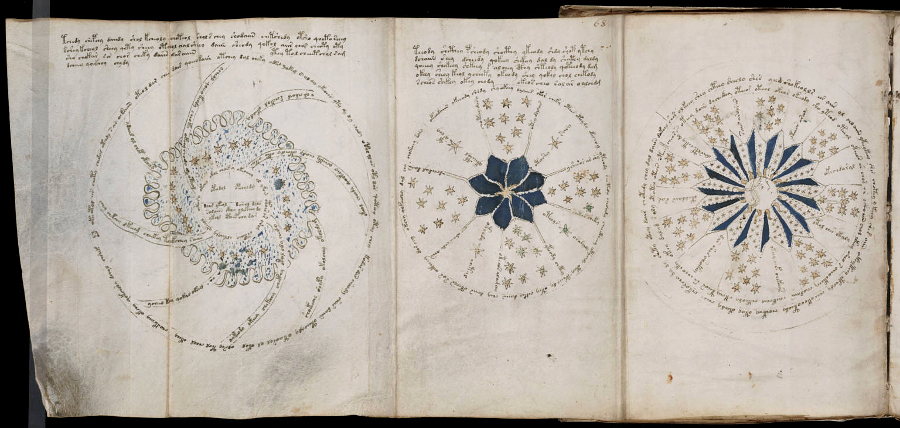
...and not think that they are related to techniques (Secreti) having to do with producing the Millefiori that Venetian glass is famous for.
Also, most of the images in the VMS that seem to show complex and unknown "topographies" of some kind now all are starting to look to me like the designs for Maiolica interior installations (ceilings and walls with votive spaces).
Maiolica, and the glass-making technique of producing Lustreware, involved the application of metals to glass and pottery and porcelain; all very secreti. Secretis within secretis: all of those manufacturing techniques.
Anyway, I wanted to share where I was at with it. I'm still processing.
Arts & Crafts Majolica Tile Wedgwood 1896:
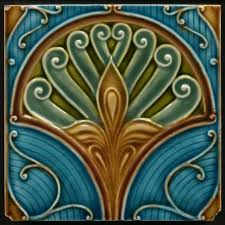
All of a sudden the Arts and Crafts Movement looks really interesting again. Not because of secrets necessarily but because it seems to represent, geez, a lot of things, not the least of which would be the common accessibility of all of the secreti, know what I mean? They aren't really secrets, they are something that comes up out of human-beingness. It's like no matter how hidden they can become, the technologies always flourish under the influence of human enthusiasm. I think something important is there that I can't quite articulate. Yet.
BRB
I don't think that Caterina is the author of the VMS. It was the "Sforza" name that Hawke offered that caused me to find Caterina, the most well known Sforza. She just came up first.
The most important thing for me in discovering Cat is the Italian and European history of Libri Di Secreti, or books of secrets. Knowing about them has allowed me to put the VMS in to historical context in a way that I never would have before.
We all have those books that we are sort of attached to, for me it's Fulcanelli's two books, Mysteries of The Cathedrals and Dwellings of The Philsophers. We are all going to read a finite amount of books before we die. Americans already have a deficit coming right out of the gate when the race begins in terms of education. Knowing both those things at an early age helped me to reaize that I had better pick a couple good ones (books) and stick with them. I have never been able to approach Dwellings in a way that satisfied me until now. Why? Because it's about interior design, architecture, and glass-making, especially stained glass; what the hell was I supposed to do with that? I was told by reliable sources that the key was in understanding post-modernism. Anyway...
So, when Hawke says "Glass", I'm guessing that he meant the whole gamut of glass-making technique.
For instance, I will never be able to see these images from the VMS again...

...and not think that they are related to techniques (Secreti) having to do with producing the Millefiori that Venetian glass is famous for.
The technical knowledge for creating millefiori was lost by the eighteenth century, and the technique was not revived until the nineteenth century. Within several years of the technique's rediscovery, factories in Italy, France and England were manufacturing millefiori canes. They were often incorporated into fine glass art paperweights.
en.wikipedia.org...
Also, most of the images in the VMS that seem to show complex and unknown "topographies" of some kind now all are starting to look to me like the designs for Maiolica interior installations (ceilings and walls with votive spaces).
Maiolica, and the glass-making technique of producing Lustreware, involved the application of metals to glass and pottery and porcelain; all very secreti. Secretis within secretis: all of those manufacturing techniques.
Anyway, I wanted to share where I was at with it. I'm still processing.
Arts & Crafts Majolica Tile Wedgwood 1896:

All of a sudden the Arts and Crafts Movement looks really interesting again. Not because of secrets necessarily but because it seems to represent, geez, a lot of things, not the least of which would be the common accessibility of all of the secreti, know what I mean? They aren't really secrets, they are something that comes up out of human-beingness. It's like no matter how hidden they can become, the technologies always flourish under the influence of human enthusiasm. I think something important is there that I can't quite articulate. Yet.
BRB
edit on 13-4-2015 by Bybyots because: . : .
Oh my god. Just sitting here with my head exploding. Thanks alot you guys.
Holy effing hell. It's one big alembic.
Speechless.
God is truly Great.
Holy effing hell. It's one big alembic.
Speechless.
en.wikipedia.org...
God is truly Great.
edit on 13-4-2015 by Bybyots because: . : .
a reply to: Bybyots
Of course glass had an important place in medieval symbolism because of it's association with light and purity of colour, but the association of Venezia with that goes a little deeper and it is the symbolism of the rainbow Goddess herself.
The discovery of herbal secrets was an aspect of the cult of Inanna, and closely related to sexual discovery;
The patterns can be related to Celestial movements and sub-divisions, they have always found their way into popular cultural motifs, but the greater mystery relates to the association of Venus with vulcanism and sulphurous emissions, and the most natural one in terms of the planet, people have always struggled with the actual nature.
The bathing illustrations relate to spa baths in areas of vulvanism such as Campagna, there is close relationship with other known illustrations, but these present a mystery in themselves.
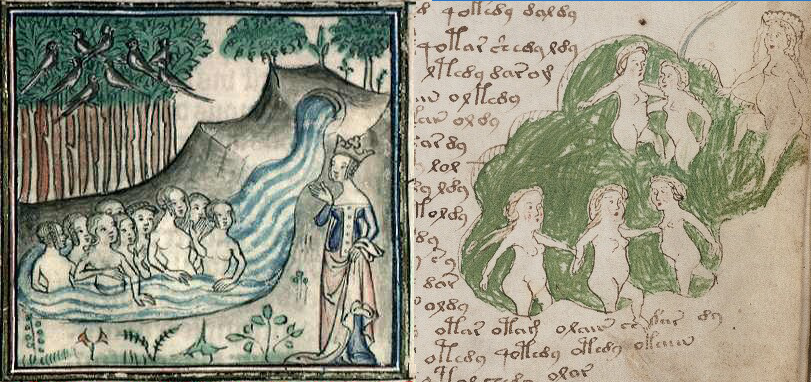
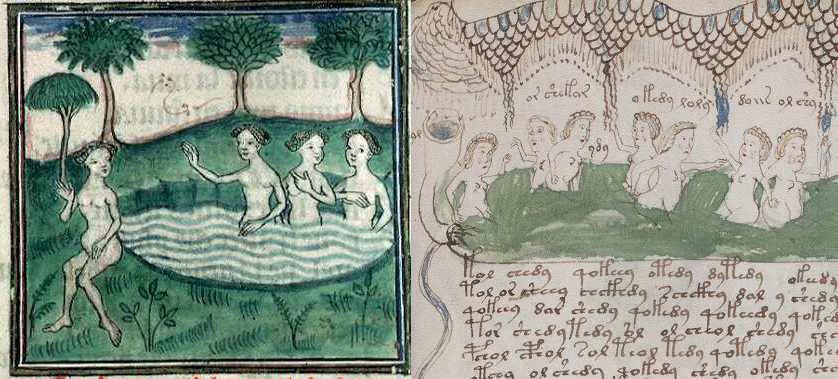
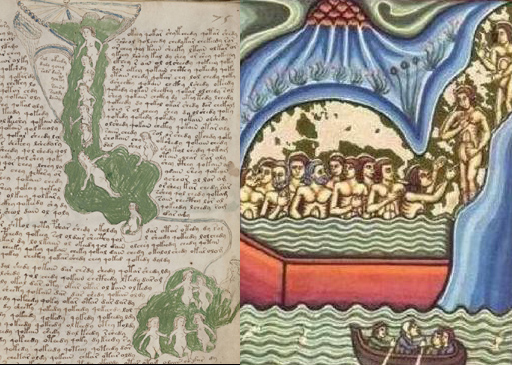
In that the ladies are unconventionally naked for the period and that there is a cultic interest in red or blonde hair;

It is a cult of Venus and it is a cult of beauty, in sulphurous spa baths, one can see how easily glass making could become an allegorized aspect of this;
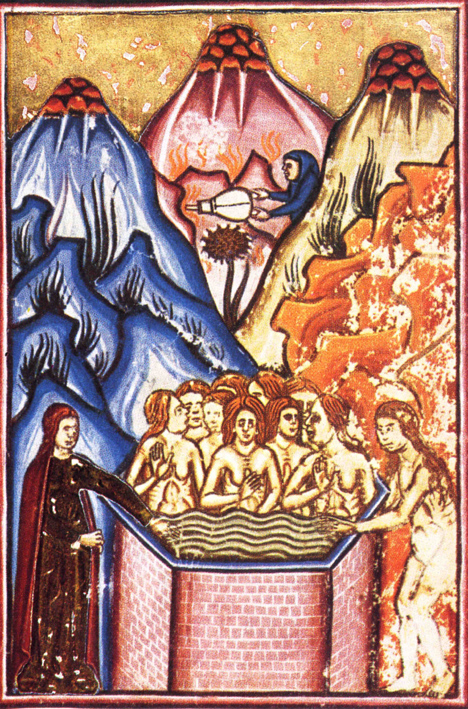
So one must note in the astrological illustrations that all stars that rise in a particular zodiacal month have connection to celestial ladies and that these themselves are popping out the end of venting tubes, and this then leads on to those same venting tubes leading into collective pools and the whole is an intricate network, similar to the honeycomb of a volcanic region, and so in a sense inter-connectivity of the Heavens also relates to such flowing vents.
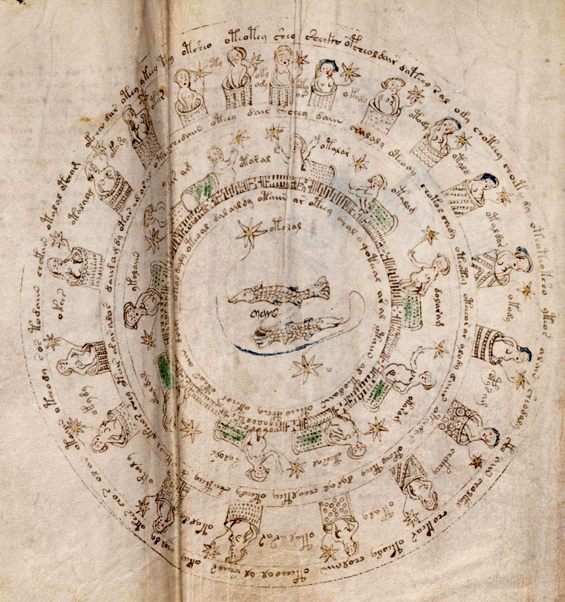
Herbal & Balneis Puteolanist
Illuminated manuscripts-Bathing
Of course glass had an important place in medieval symbolism because of it's association with light and purity of colour, but the association of Venezia with that goes a little deeper and it is the symbolism of the rainbow Goddess herself.
The discovery of herbal secrets was an aspect of the cult of Inanna, and closely related to sexual discovery;
Inana speaks "My brother, awe-inspiring lord, let me ride with you to the mountains! Lord of heaven, awe-inspiring lord, lord, let me ride with you to the mountains;
I am unfamiliar with womanly matters, with ....... I am unfamiliar with womanly matters, with sexual intercourse! I am unfamiliar with womanly matters, with kissing! I am unfamiliar with sexual intercourse, I am unfamiliar with kissing!
"Whatever exists in the mountains, let us eat that. Whatever exists in the hills, let us eat that. In the mountains of herbs, in the mountains of cedars, in the mountains of cedars, the mountains of cypresses, whatever exists in the mountains, let us eat that.
The patterns can be related to Celestial movements and sub-divisions, they have always found their way into popular cultural motifs, but the greater mystery relates to the association of Venus with vulcanism and sulphurous emissions, and the most natural one in terms of the planet, people have always struggled with the actual nature.
The bathing illustrations relate to spa baths in areas of vulvanism such as Campagna, there is close relationship with other known illustrations, but these present a mystery in themselves.



In that the ladies are unconventionally naked for the period and that there is a cultic interest in red or blonde hair;

It is a cult of Venus and it is a cult of beauty, in sulphurous spa baths, one can see how easily glass making could become an allegorized aspect of this;

So one must note in the astrological illustrations that all stars that rise in a particular zodiacal month have connection to celestial ladies and that these themselves are popping out the end of venting tubes, and this then leads on to those same venting tubes leading into collective pools and the whole is an intricate network, similar to the honeycomb of a volcanic region, and so in a sense inter-connectivity of the Heavens also relates to such flowing vents.

Herbal & Balneis Puteolanist
Illuminated manuscripts-Bathing
edit on Kpm430102vAmerica/ChicagoMonday1330 by Kantzveldt because: (no reason given)
edit on
Kpm430102vAmerica/ChicagoMonday1330 by Kantzveldt because: (no reason given)
a reply to: Kantzveldt
Whoa, that's weird. I was just thinking of Vulcan and Hephaistos when I logged back in.
Brilliant post, K, it's been difficult for me to lend any perspective to the baths for myself, short of intuiting that they would be medicinal/rejuvenative. More "Courtly Technology"?
I think we are in a groove here and it might no longer be possible to make a bad "guess" at what the VMS "is".
Venus makes me want to post one of these...

...rather than to go in to the usual spiel about honey-bees and labor.
Whoa, that's weird. I was just thinking of Vulcan and Hephaistos when I logged back in.
Brilliant post, K, it's been difficult for me to lend any perspective to the baths for myself, short of intuiting that they would be medicinal/rejuvenative. More "Courtly Technology"?
I think we are in a groove here and it might no longer be possible to make a bad "guess" at what the VMS "is".
Venus makes me want to post one of these...

...rather than to go in to the usual spiel about honey-bees and labor.
edit on 13-4-2015 by Bybyots because: . : .
a reply to: Bybyots
Yes all very curious, it is no more about glass making that it is about hair tinctures or cosmetics or herbal remedies and elixirs of longevity, though it is about all those, about the quest for beauty as in the Florentine ideal, mathematics, ratios, harmonies, about our relationship to the Cosmos and how we reflect it in our nature...in short renaissance thought but more ancient in origin and of the fish people.
If you look at the bathing in volcanic region manuscripts one can see the mountains broken down into three primary colours, red, blue, yellow, they are relating vulcanism to the purification of elements in the fiery furnace, at the geological level but also that will carry through into the practical, cosmological and spiritual alchemy.
The Fish that swam in the Great Bath
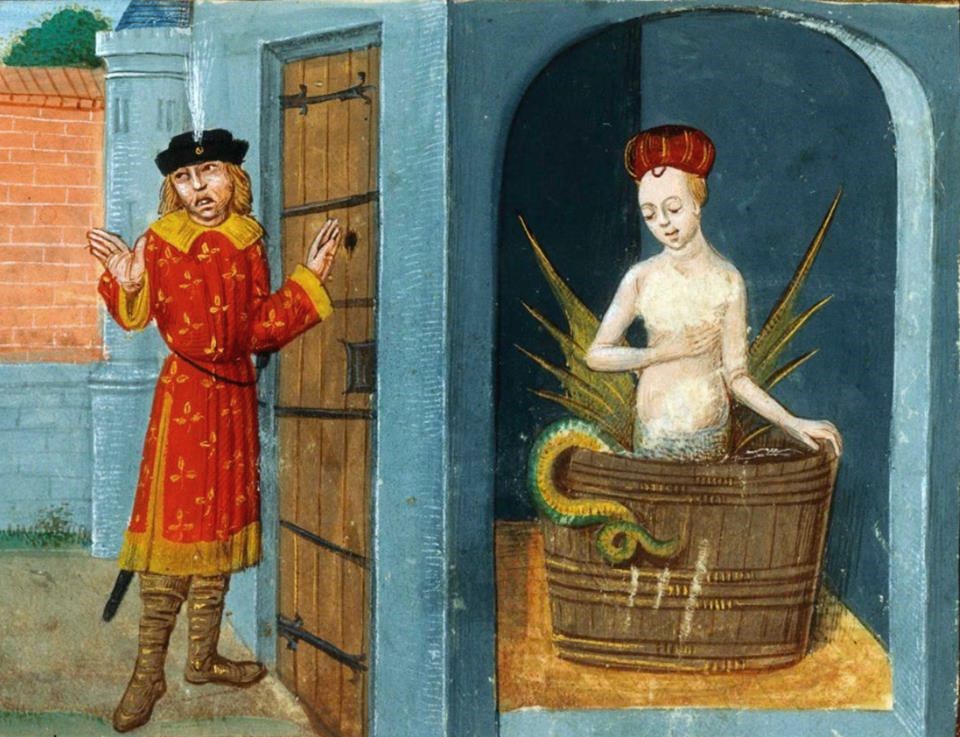
Yes all very curious, it is no more about glass making that it is about hair tinctures or cosmetics or herbal remedies and elixirs of longevity, though it is about all those, about the quest for beauty as in the Florentine ideal, mathematics, ratios, harmonies, about our relationship to the Cosmos and how we reflect it in our nature...in short renaissance thought but more ancient in origin and of the fish people.
In short, the so-called ‘Great Bath’ was a Sacred Pool for ritual bathing by the priests and priestesses of the Temple...
What is new in the present study is that interpretation of the function of the ‘Great Bath’ has led to the identification of the FISH signs as ideograms representing the water nymphs whose activities centered round the Great Bath
The apsarases are described as irresistibly beautiful women who would entice men to consort with them and eventually lead the heroes to destruction.
These bathing beauties were also accomplished in song and dance. The demigoddesses had individual names and each was associated with some particular locality.
Several ancient Indian dynasties were supposed to have descended from the temporary union of some particular apsaras with a hero.
If you look at the bathing in volcanic region manuscripts one can see the mountains broken down into three primary colours, red, blue, yellow, they are relating vulcanism to the purification of elements in the fiery furnace, at the geological level but also that will carry through into the practical, cosmological and spiritual alchemy.
The Fish that swam in the Great Bath

edit on Kpm430102vAmerica/ChicagoMonday1330 by Kantzveldt because: (no reason given)
When i was working on studying the manuscript, I thought that it seemed it was a combination language. I think it is a made up script and it's made
from shorthand latin and italian. Sadly i'm not familiar enough with the 14/15th century shorthand of either of these languages (let alone the actual
language) to decipher it. Personally I think it was written by someone like Da Vinci or Bacon (although I'm not sure it was either one of them - just
someone like them) probably dealing with alchemy.
As others have mentioned, it's possible that this is a book that was passed down and copied several times. Another thing that I noticed is that in the digital copies, some of the letters appear fainter than others, which makes it difficult at times to copy it. I've never seen the original but certainly wish that i could.
As others have mentioned, it's possible that this is a book that was passed down and copied several times. Another thing that I noticed is that in the digital copies, some of the letters appear fainter than others, which makes it difficult at times to copy it. I've never seen the original but certainly wish that i could.
a reply to: Kantzveldt
You know what else is is really cool? Imagining the VMS like this in its new historical context alongside other Libri Di Secreti like Caterina's or the Piedmont suddenly makes things like this Edwardian lustreware tea set take on deep philosophical significance.

streetsofsalem.com...
I mean everything about it, not just the technical aspects of its manufacture, but also the middle class Edwardian consumer base that demanded it; and loved them as their cherished posessions. And also things like why it would be important to some that later, years after they were sold as new items in stores, that they be featured with the "right" tea service table from the same era presented in a room with the "right" wallpaper.
It all starts to take on the same intense lustre of importance and meaning as any work of art with much more overt hermetic symbolism.
P.S. I am never going to be able to see Adam Curtis' The Century of Self the same way again.
You know what else is is really cool? Imagining the VMS like this in its new historical context alongside other Libri Di Secreti like Caterina's or the Piedmont suddenly makes things like this Edwardian lustreware tea set take on deep philosophical significance.

streetsofsalem.com...
I mean everything about it, not just the technical aspects of its manufacture, but also the middle class Edwardian consumer base that demanded it; and loved them as their cherished posessions. And also things like why it would be important to some that later, years after they were sold as new items in stores, that they be featured with the "right" tea service table from the same era presented in a room with the "right" wallpaper.
It all starts to take on the same intense lustre of importance and meaning as any work of art with much more overt hermetic symbolism.
P.S. I am never going to be able to see Adam Curtis' The Century of Self the same way again.
edit on 13-4-2015 by Bybyots because: . : .
a reply to: Bybyots
Yes the quest for refinement, perfection of the soul or if not that at least the silverware, i think the original premise was through genetics rather than hair tinctures and cosmetics, a question of breeding, all under the auspices of the Goddess of sexuality and her seven sisters of the Pleiades.
I painted the picture of what for me constituted pretty much the sum of all mysteries, probably should have left it at that and put aside ever trying to understand let alone explain, like a proper artist.

Yes the quest for refinement, perfection of the soul or if not that at least the silverware, i think the original premise was through genetics rather than hair tinctures and cosmetics, a question of breeding, all under the auspices of the Goddess of sexuality and her seven sisters of the Pleiades.
I painted the picture of what for me constituted pretty much the sum of all mysteries, probably should have left it at that and put aside ever trying to understand let alone explain, like a proper artist.

Here's to repeating the same mistakes...

timewalker,
Bybyots,
Kantsveldt
-Respect.

timewalker,
Bybyots,
Kantsveldt
-Respect.
a reply to: Hawke
Hawke,
Just wanted to let you know that I personally haven't pointed myself at the VMs since the last time we were all doing this together and I haven't even picked up Fulcanelli in more than a year. My mind has been on school, work, systems theory and all things Norbert Wiener; not the occult.
When you dropped the word "Sforza" I shot out of the cave like a bat from hell, in my rush I noticed on a forum that someone named Nick Pelling was involved, but I was on a roll and didn't want Nick's stuff spoiling my tea party. Yet.
Anyhow, so off I go with my exploding head and I write up these posts for this thread, it's all clicking together for me, as you can see.
Mistakes? Did we repeat the same mistakes as others? Did I repeat the same mistakes? That's cool, I'm used to that as being a regular feature of "studying" this stuff, so I am always prepared to be wildly wrong and have a laugh at myself.
Finally I go to check out Nick Pelling. He's got a book and a theory. I look at the posts below some of his blog posts and I see that others are discussing majollaca-ware. Whoa, I had gotten there under my own steam, the last thing I expected anywhere was to see the word "majollaca" used in the same sentence as Voynich. So I see that I have found the same tree to bark up that others have.
I greatly appreciate your participation in this thread and the opportunity to move this story forward to anywhere. Even if it's the same mistaken place that others have found, having gotten lost will be edifying.
Your thoughts on this would be most appreciated.
Thanks and have a good day.
Hawke,
Just wanted to let you know that I personally haven't pointed myself at the VMs since the last time we were all doing this together and I haven't even picked up Fulcanelli in more than a year. My mind has been on school, work, systems theory and all things Norbert Wiener; not the occult.
When you dropped the word "Sforza" I shot out of the cave like a bat from hell, in my rush I noticed on a forum that someone named Nick Pelling was involved, but I was on a roll and didn't want Nick's stuff spoiling my tea party. Yet.
Anyhow, so off I go with my exploding head and I write up these posts for this thread, it's all clicking together for me, as you can see.
Mistakes? Did we repeat the same mistakes as others? Did I repeat the same mistakes? That's cool, I'm used to that as being a regular feature of "studying" this stuff, so I am always prepared to be wildly wrong and have a laugh at myself.
Finally I go to check out Nick Pelling. He's got a book and a theory. I look at the posts below some of his blog posts and I see that others are discussing majollaca-ware. Whoa, I had gotten there under my own steam, the last thing I expected anywhere was to see the word "majollaca" used in the same sentence as Voynich. So I see that I have found the same tree to bark up that others have.
I greatly appreciate your participation in this thread and the opportunity to move this story forward to anywhere. Even if it's the same mistaken place that others have found, having gotten lost will be edifying.
Your thoughts on this would be most appreciated.
Thanks and have a good day.
edit on 14-4-2015 by Bybyots because: . : .
a reply to: Kantzveldt
I was trying to find you a lustreware disco ball, but no one has made one, yet.
So, instead, I'd like to invite you to put the word Bakelite in to Images. It's almost as much fun as a lustreware disco ball.
I was trying to find you a lustreware disco ball, but no one has made one, yet.
So, instead, I'd like to invite you to put the word Bakelite in to Images. It's almost as much fun as a lustreware disco ball.
For the record. I was not the 'Mr. Anomynous'. I missed that in the reply! Go figure!!!
a reply to: CraftBuilder
Over 70 words and names gleaned using a new transcription alphabet indicate constructions of an old Finno-Ugric origin with a substantial amount of Old Norse. In addition, there is a distinct Slavic influence. Some of the pages contain text suggestive of Karelian runic charm songs or Sami joiks in that they are highly alliterative and trochaic.
Unlocking the Voynich Manuscript
The pages depict female heliocentric star charts resembling Nordic brooches. They also depict kolovrats, octagrams, sauna/banya, torcs, a seidr staff, a distaff, a drop spindle, ceremonial spoons, the sun cross symbol, intercalary year, red conical roofs, onion domes, plants from the northern hemisphere, a landscape resembling the Ruskeala marble caves, zaftig fair blond women, a Permic-like lizard of the underworld, the pike of Tuonela, and runic glyphs (comparable to those found in Icelandic magic books).
Some visual designs are reminiscent of a Sami shamanic drum, Karelian embroidery, and Vologda lace. The herbal powder receptacles are modified sewing necessaires in the tradition of north European treenware.
All of this points to core elements of north European culture that can be found in Scandinavian, Finno-Ugric, north Germanic, and to some extent Celtic traditions. These belief systems go back thousands of years.
Over 70 words and names gleaned using a new transcription alphabet indicate constructions of an old Finno-Ugric origin with a substantial amount of Old Norse. In addition, there is a distinct Slavic influence. Some of the pages contain text suggestive of Karelian runic charm songs or Sami joiks in that they are highly alliterative and trochaic.
Unlocking the Voynich Manuscript
The pages depict female heliocentric star charts resembling Nordic brooches. They also depict kolovrats, octagrams, sauna/banya, torcs, a seidr staff, a distaff, a drop spindle, ceremonial spoons, the sun cross symbol, intercalary year, red conical roofs, onion domes, plants from the northern hemisphere, a landscape resembling the Ruskeala marble caves, zaftig fair blond women, a Permic-like lizard of the underworld, the pike of Tuonela, and runic glyphs (comparable to those found in Icelandic magic books).
Some visual designs are reminiscent of a Sami shamanic drum, Karelian embroidery, and Vologda lace. The herbal powder receptacles are modified sewing necessaires in the tradition of north European treenware.
All of this points to core elements of north European culture that can be found in Scandinavian, Finno-Ugric, north Germanic, and to some extent Celtic traditions. These belief systems go back thousands of years.
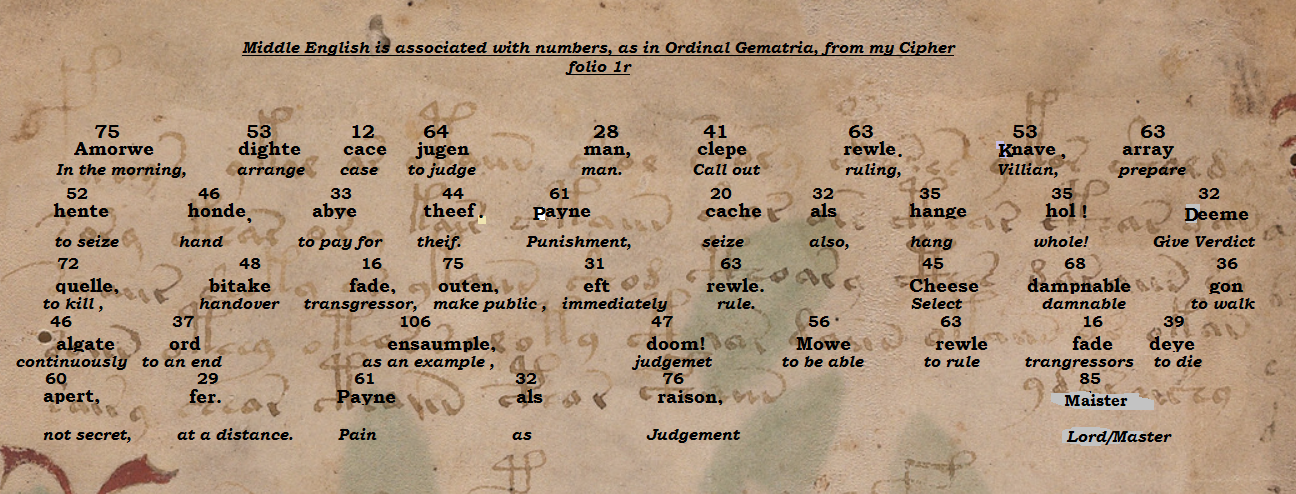
voynichgematria.wordpress.com...
Why has the VMS garnished so much attention from amateur and professional cryptographers, programmers, linguists and art historians? Truly I believe that at first glance by all it looks like the VMS text can be read. That in the moment of the first glance it looks simple, but once fully invested the person realizes the VMS is highly complex. For what it’s worth, what I have found is the translation is not all that exciting. Language frequencies have been applied to the VMS without finding any consistent language that fits a straight across translation. This has led some to believe the VMS is a hoax or an invented language. I believe the latter! What would cause so many failed attempts at decoding the VMS? The author would invent a language as a cipher of scrambled letters replacing words to numbers in the invented language and to further complicate it, make it look like a known language. What I propose is that the VMS glyphs have been strategically placed and that the letter values being numbers are of Middle English Gematria origin. This is known as ordinal gematria.
new topics
-
God's Righteousness is Greater than Our Wrath
Religion, Faith, And Theology: 3 hours ago -
Electrical tricks for saving money
Education and Media: 7 hours ago -
VP's Secret Service agent brawls with other agents at Andrews
Mainstream News: 8 hours ago -
Sunak spinning the sickness figures
Other Current Events: 9 hours ago -
Nearly 70% Of Americans Want Talks To End War In Ukraine
Political Issues: 9 hours ago -
Late Night with the Devil - a really good unusual modern horror film.
Movies: 11 hours ago
top topics
-
VP's Secret Service agent brawls with other agents at Andrews
Mainstream News: 8 hours ago, 9 flags -
Cats Used as Live Bait to Train Ferocious Pitbulls in Illegal NYC Dogfighting
Social Issues and Civil Unrest: 12 hours ago, 8 flags -
Electrical tricks for saving money
Education and Media: 7 hours ago, 4 flags -
HORRIBLE !! Russian Soldier Drinking Own Urine To Survive In Battle
World War Three: 16 hours ago, 3 flags -
Nearly 70% Of Americans Want Talks To End War In Ukraine
Political Issues: 9 hours ago, 3 flags -
Sunak spinning the sickness figures
Other Current Events: 9 hours ago, 3 flags -
Late Night with the Devil - a really good unusual modern horror film.
Movies: 11 hours ago, 2 flags -
The Good News According to Jesus - Episode 1
Religion, Faith, And Theology: 14 hours ago, 1 flags -
God's Righteousness is Greater than Our Wrath
Religion, Faith, And Theology: 3 hours ago, 0 flags
active topics
-
Sunak spinning the sickness figures
Other Current Events • 6 • : angelchemuel -
HORRIBLE !! Russian Soldier Drinking Own Urine To Survive In Battle
World War Three • 33 • : Degradation33 -
How ageing is" immune deficiency"
Medical Issues & Conspiracies • 34 • : angelchemuel -
Nearly 70% Of Americans Want Talks To End War In Ukraine
Political Issues • 13 • : Freeborn -
Mood Music Part VI
Music • 3101 • : ThatSmellsStrange -
VP's Secret Service agent brawls with other agents at Andrews
Mainstream News • 41 • : ThatSmellsStrange -
New whistleblower Jason Sands speaks on Twitter Spaces last night.
Aliens and UFOs • 55 • : baablacksheep1 -
Cats Used as Live Bait to Train Ferocious Pitbulls in Illegal NYC Dogfighting
Social Issues and Civil Unrest • 20 • : Asher47 -
Electrical tricks for saving money
Education and Media • 4 • : Lumenari -
DONALD J. TRUMP - 2024 Candidate for President - His Communications to Americans and the World.
2024 Elections • 514 • : WeMustCare


